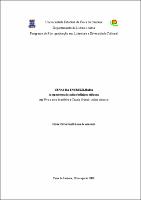| Compartilhamento |


|
Use este identificador para citar ou linkar para este item:
http://tede2.uefs.br:8080/handle/tede/1254Registro completo de metadados
| Campo DC | Valor | Idioma |
|---|---|---|
| dc.creator | Azevedo, Silvia Olivia Smith Lima de | - |
| dc.creator.Lattes | http://lattes.cnpq.br/1279490135994599 | por |
| dc.contributor.advisor1 | Pereira, Elvya Shirley Ribeiro | - |
| dc.date.accessioned | 2021-06-28T23:32:04Z | - |
| dc.date.issued | 2009-08-28 | - |
| dc.identifier.citation | AZEVEDO, Silvia Olivia Smith Lima de. Cenas da encruzilhada: A representação mítico/religiosa africana em Viva o povo brasileiro e Tocaia Grande: a face obscura. 2009. 103 f. Dissertação (Mestrado Acadêmico em Literatura e Diversidade Cultural)- Universidade Estadual de Feira de Santana, Feira de Santana, 2009. | por |
| dc.identifier.uri | http://tede2.uefs.br:8080/handle/tede/1254 | - |
| dc.description.resumo | Este trabalho estuda a representação mítico/religiosa africana nos romances Viva o povo brasileiro (1984), de João Ubaldo Ribeiro e Tocaia Grande: a face obscura (1984), de Jorge Amado com o objetivo de demarcar, na arquitetura de tais obras, a contribuição cultural de raiz africana, notadamente, das narrativas míticas ligadas ao sistema oracular da tradição nagô: os itans. O estudo se assenta na reflexão das relações dialógicas entre os mitos, expressos nas práticas orais e performáticas das religiões afro-brasileiras, e sua recriação literária na produção escrita contemporânea. Categorias como encruzilhada, oralidade, performance, ancestralidade serão acionadas como operadores de leitura, em consonância com os postulados teóricos, críticos e históricos de estudiosos das culturas africanas e afrobrasileiras: Juana Elbein dos Santos (1986), João José Reis (1991), Paul Zumthor (1993), Laura Padilha (1995), Leda Maria Martins (1997), Eduardo David Oliveira (2006), Amarino Oliveira de Queiroz (2007), Rui do Carmo Póvoas (2007). Pretendemos demonstrar como o conhecimento mítico/religioso africano, preservado pelos rituais e redimensionados pela escrita literária, constitui um traço marcante da resistência cultural negra após a Diáspora. Nesse contexto de mesclas culturais, entrecruzam-se dualidades em conflito: memória e história, sagrado e profano, oral e escrito, individual e coletivo, passividade e resistência. | por |
| dc.description.abstract | This paper studies the mythical/religious representation in the novels Viva o Povo Brasileiro by João Ubaldo Ribeiro (1984) and Tocaia Grande by Jorge Amado (1986), with the objective to realize, in the making of such work, the imprint of the African cultural root contribution, most of all the mythical narratives linked to the language of the Nagô tradition: the Itans. This study is settled in the consideration of the dialog relations among the myths, expressed in the typical and oral practice performances of the Afro-Brazilian religions, and its literary reborn in the contemporaneous writing production. Categories such as, crossings, oral practice, performance, ancestors, will be used as tools of reading according to theoretical, critical and historical postulates from African and Afro-Brazilian culture, such as Juana Elbein dos Santos (1986), João José Reis (1991), Paul Zumthor (1993), Laura Padilha (1995), Leda Maria Martins (1997), Eduardo David Oliveira (2006) , Amarino Oliveira de Queiroz (2007), Rui do Carmo Póvoas(2007); we intend to demonstrate how the African mythical/religious knowledge preserved by the rituals and re-dimensioned by writing constitutes a mark of the African cultural resistance after the Diaspora. In this context of cultural mixture, there is a clash of dualities in conflict: memory and history, sacred and profane, oral and written, individual and collective, passivity and resistance. | eng |
| dc.description.provenance | Submitted by Bruno Matos Nascimento (brunomatos@uefs.br) on 2021-06-28T23:32:04Z No. of bitstreams: 1 Dissertação Silvia Smith.pdf: 779446 bytes, checksum: 3b1aa1f1e6e232ed9e048134696746ed (MD5) | eng |
| dc.description.provenance | Made available in DSpace on 2021-06-28T23:32:04Z (GMT). No. of bitstreams: 1 Dissertação Silvia Smith.pdf: 779446 bytes, checksum: 3b1aa1f1e6e232ed9e048134696746ed (MD5) Previous issue date: 2009-08-28 | eng |
| dc.format | application/pdf | * |
| dc.thumbnail.url | http://tede2.uefs.br:8080/retrieve/6870/Disserta%c3%a7%c3%a3o%20Silvia%20Smith.pdf.jpg | * |
| dc.language | por | por |
| dc.publisher | Universidade Estadual de Feira de Santana | por |
| dc.publisher.department | DEPARTAMENTO DE LETRAS E ARTES | por |
| dc.publisher.country | Brasil | por |
| dc.publisher.initials | UEFS | por |
| dc.publisher.program | Mestrado Acadêmico em Literatura e Diversidade Cultural | por |
| dc.rights | Acesso Aberto | por |
| dc.subject | Cultura africana | por |
| dc.subject | Literatura afro-brasileira | por |
| dc.subject | Oralidade | por |
| dc.subject | Performance | por |
| dc.subject | Memória | por |
| dc.subject | African culture | eng |
| dc.subject | Afro-Brazilian literature | eng |
| dc.subject | Oral practice | eng |
| dc.subject | Performance | eng |
| dc.subject | Memory | eng |
| dc.subject.cnpq | LINGUISTICA, LETRAS E ARTES | por |
| dc.subject.cnpq | LETRAS::LITERATURA BRASILEIRA | por |
| dc.title | Cenas da encruzilhada: A representação mítico/religiosa africana em Viva o povo brasileiro e Tocaia Grande: a face obscura | por |
| dc.type | Dissertação | por |
| Aparece nas coleções: | Coleção UEFS | |
Arquivos associados a este item:
| Arquivo | Descrição | Tamanho | Formato | |
|---|---|---|---|---|
| Dissertação Silvia Smith.pdf | Arquivo em texto completo | 761,18 kB | Adobe PDF |  Baixar/Abrir Pré-Visualizar |
Os itens no repositório estão protegidos por copyright, com todos os direitos reservados, salvo quando é indicado o contrário.




